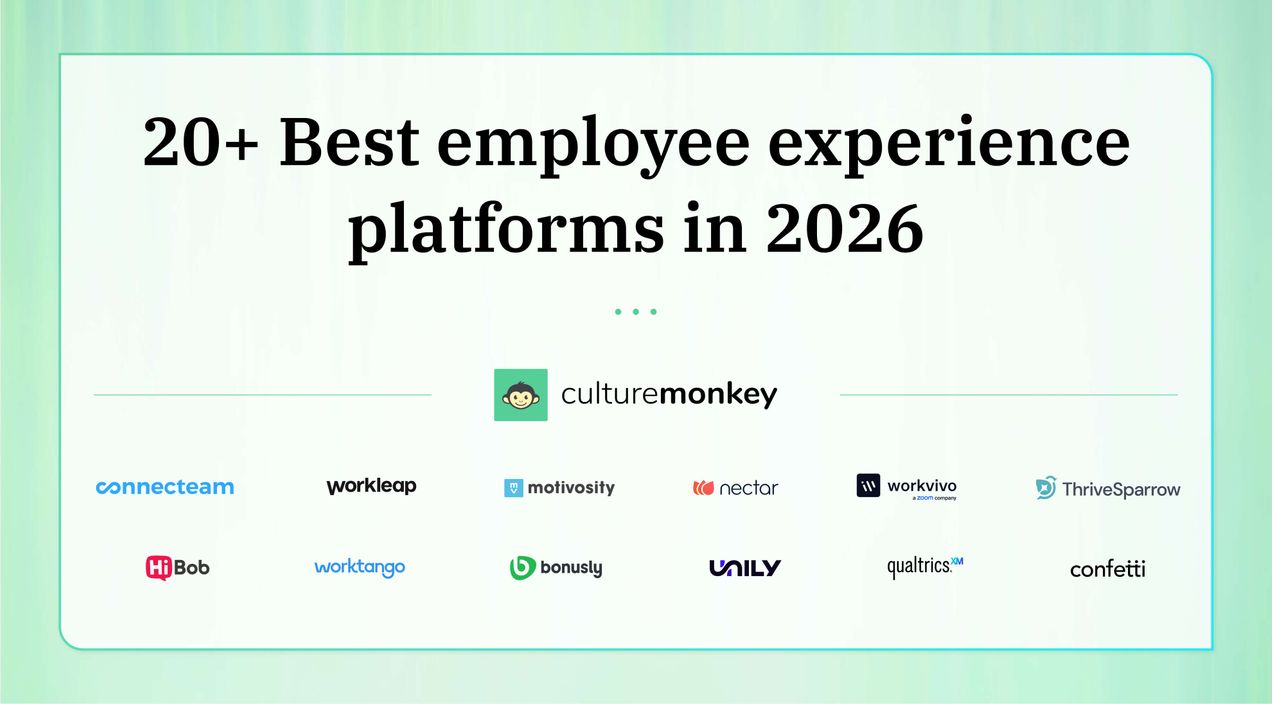15 Best ways to understand employee satisfaction and boost morale as leaders in 2024

Employee satisfaction and morale are critical drivers of organizational success, yet they often remain elusive metrics for leaders. As we progress through 2024, understanding and enhancing these elements is more important than ever.
With shifting workforce dynamics and evolving expectations, leaders must adopt innovative strategies to gauge and improve job satisfaction and engagement more effectively. Happy and well-supported employees deliver better service, which directly enhances customer experiences and loyalty.
This blog explores what are the best ways to understand employee satisfaction and also how to actively boost morale. From leveraging advanced analytics to implementing personalized feedback mechanisms, we will delve into contemporary practices that can transform workplace culture.
By focusing on actionable insights and practical approaches, this guide aims to equip leaders with the tools needed to foster a motivated and contented workforce.
Whether you’re seeking to refine your current practices or implement new ones, these strategies will provide valuable guidance in creating a positive and productive work environment.
What is employee satisfaction?

Employee satisfaction refers to the level of contentment employees feel regarding their jobs and work environment. It encompasses various aspects of the workplace experience, including job role, working conditions, salary, benefits, and the quality of relationships with colleagues and supervisors. High employee satisfaction typically leads to increased motivation, productivity, and loyalty, while low satisfaction can result in high turnover rates and decreased performance.
The key factors influencing employee satisfaction include clear communication, opportunities for career development, work-life balance, and recognition of achievements. When employees feel valued and supported, they are more likely to be engaged and committed to their roles. Effective management practices, such as providing constructive feedback and fostering a positive work culture, also play a crucial role in enhancing satisfaction.
Employers often measure employee satisfaction through surveys and feedback mechanisms, which help identify areas needing improvement and track changes over time. Collecting employee feedback through various methods, including innovative approaches like sentiment analysis, is crucial for understanding and improving employee satisfaction.
Why is employee satisfaction important?

Satisfied employees are more engaged, motivated, and committed to their roles, which leads to higher performance and lower turnover rates. Let’s take a look at the myriad of benefits it offers.
- Productivity and performance: Satisfied employees are generally more motivated and engaged, leading to higher productivity and better performance. They are more likely to put in extra effort and contribute positively to team goals.
- Employee retention: High levels of satisfaction reduce turnover rates. Employees who are happy with their work environment and roles are less likely to leave, which helps retain talent and maintain continuity within teams.
- Company culture: Employee satisfaction contributes to a positive workplace culture. When employees are satisfied, they are more likely to collaborate effectively, foster good relationships, and support a healthy, dynamic work environment.
- Customer satisfaction: Satisfied employees often lead to satisfied customers. Happy employees provide better service and interact more positively with customers, which can enhance the overall customer experience and drive business success.
- Innovation and creativity: A satisfied workforce is more likely to be innovative and creative. When employees feel valued and content, they are more willing to share ideas and contribute to problem-solving and innovation.
- Reduced absenteeism: Employees who are satisfied with their jobs are less likely to be absent. Lower absenteeism reduces disruptions and maintains productivity levels.
- Financial performance: There is a strong link between employee satisfaction and financial performance. Companies with high levels of employee satisfaction often see improved profitability due to increased efficiency, lower turnover, and better customer satisfaction.
Employee engagement vs employee satisfaction: What is the difference?

Although both concepts are related to employees' experiences at work, they focus on different aspects of their relationship with the organization. Let’s understand the difference between them.
- Employee satisfaction: Employee satisfaction refers to how content employees are with their job and working conditions. It is a measure of how well employees' basic needs and expectations are met.
- Work environment: This includes the physical workspace, office amenities, and overall comfort. A positive work environment contributes to employees' satisfaction by making their daily tasks more pleasant.
- Compensation and benefits: This encompasses salary, health benefits, retirement plans, and other perks. Competitive and fair compensation is a fundamental aspect of job satisfaction.
- Job security: Employees' feelings of stability and assurance regarding their employment status. Job security can affect how satisfied employees feel about their role and their trust in the organization.
- Employee engagement: Employee engagement measures the emotional investment employees have in their work and their commitment to the organization's success. It reflects how motivated and connected employees feel about their roles and the company's mission.
- Emotional investment: This refers to the level of enthusiasm and passion employees have for their work. Engaged employees find their work meaningful and are emotionally involved in their daily tasks.
- Commitment to goals: Engaged employees are aligned with the organization’s objectives and are willing to put in extra effort to achieve them. They take ownership of their work and are dedicated to contributing to the company's success.
- Extra effort: This includes employees' willingness to go above and beyond their basic job responsibilities. Engaged employees often show initiative, seek out opportunities for improvement, and contribute to a positive workplace culture.
What are the key 6 elements that drive employee satisfaction?

By focusing on these six elements, organizations can enhance job satisfaction, improve retention, and foster a more motivated and productive workforce.
- Work-life balance: Employees value the ability to balance their professional and personal lives. Flexible working hours, remote work options, and support for personal commitments contribute significantly to job satisfaction.
- Career development opportunities: Employees seek opportunities for growth and advancement. Providing training, mentorship, and clear career paths can enhance satisfaction by showing commitment to their professional development.
- Recognition and appreciation: Regular acknowledgment of employees’ efforts and achievements fosters a positive work environment. Genuine praise, rewards, and recognition for hard work help employees feel valued and motivated.
- Work environment: A positive, inclusive, and supportive work culture is essential. An environment where employees feel respected, safe, and part of a team contributes to overall job satisfaction.
- Management and leadership: Effective and supportive management practices, including transparent communication, fairness, and respect, are crucial. Leaders who actively listen and address employees’ concerns can greatly impact satisfaction levels.
- Job role and responsibilities: Employees need to find their work fulfilling and aligned with their skills and interests. Clearly defined roles, meaningful work, and the autonomy to make decisions contribute to higher job satisfaction.
5 Best metrics to consider when measuring employee satisfaction

When measuring employee satisfaction, it’s important to use employee satisfaction metrics that provide a comprehensive view of how employees feel about their work environment and job roles. Here are five key metrics to consider:
1. Employee satisfaction surveys
These are direct tools for gauging overall contentment. Employee satisfaction surveys often include questions about team satisfaction, job role clarity, work environment, management support, and compensation. Analyzing responses helps identify areas of satisfaction and dissatisfaction.
2. Employee Net Promoter Score (eNPS)
Employee Net Promoter Score metric measures the likelihood of employees recommending the company as a place to work. It provides insight into overall employee sentiment and loyalty. A high enps indicates strong customer satisfaction and commitment.
3. Turnover rates
Tracking how often employees leave the organization can signal satisfaction levels. High turnover might indicate underlying issues with job satisfaction, such as poor management or inadequate compensation.
4. Absenteeism rates
Frequent absences can be a sign of low satisfaction or disengagement. Monitoring absenteeism helps identify potential dissatisfaction or health-related issues impacting employee well-being.
5. Performance reviews
Feedback from performance evaluations can reveal how satisfied employees are with their roles and growth opportunities. Positive reviews often correlate with higher satisfaction levels, while negative feedback might highlight areas needing improvement.
The cost of an unhappy workforce

The cost of an unhappy workforce is considerable and can severely impact an organization’s bottom line. Disengaged employees often show a significant decline in productivity, with Gallup estimating that these workers result in $1.9 trillion in lost productivity as compared to their satisfied peers.
This productivity drop can lead to substantial financial losses, with disengaged employees costing U.S. businesses between $450 billion and $550 billion annually reports Gallup. Additionally, high turnover rates linked to employee dissatisfaction further strain resources.
The Society for Human Resource Management (SHRM) highlights that replacing an employee can cost between 6 to 9 months of their salary. For instance, if an employee earns $60,000 a year, the replacement costs could range from $30,000 to $45,000.
This combination of reduced productivity, high turnover, and increased absenteeism underscores the substantial financial burden of an unhappy workforce, emphasizing the need for organizations to invest in employee satisfaction to foster a more engaged and efficient workforce.
Top 7 ways to measure and interpret employee satisfaction levels as a leader
Measuring and interpreting employee satisfaction levels is critical for leaders seeking to improve workplace dynamics and performance. By utilizing effective methods to gauge employee sentiment, leaders can gain valuable insights into their team’s well-being and identify areas for improvement.
Exploring these top 7 ways to measure and interpret satisfaction helps ensure that leaders make informed decisions to enhance employee engagement and overall organizational health.
1. Employee surveys
Tracking employee satisfaction metrics through regular surveys is one of the most effective ways to gauge employee satisfaction. These surveys can include questions on job satisfaction, work environment, and management effectiveness. Analyze the results to identify trends and areas for improvement.
2. One-on-one meetings
Regular one-on-one meetings with employees provide an opportunity for open dialogue. These discussions can reveal insights into individual satisfaction levels and specific concerns that may not be captured in surveys.
3. Exit interviews
Conducting exit interviews with departing employees can provide valuable feedback on their reasons for leaving and their overall experience. This information can help identify patterns and areas needing attention.
4. Employee net promoter score (Enps)
The ENPs measure how likely employees are to recommend the company as a great place to work. A high enps indicates strong employee satisfaction, while a low score can signal underlying issues.
5. Pulse surveys
Short, frequent pulse surveys can provide real-time insights into employee satisfaction and morale. These quick check-ins help monitor changes and address issues before they escalate.
6. Performance metrics
Analyzing performance metrics such as productivity, absenteeism, and turnover rates can offer indirect indicators of employee satisfaction. A decline in performance or an increase in absenteeism may suggest underlying dissatisfaction.
7. Focus groups
Organizing focus groups with employees from various departments can facilitate in-depth discussions about satisfaction and workplace issues. These sessions can uncover nuanced feedback and generate actionable recommendations.
15 Best practices for boosting employee satisfaction in 2024

Implementing best practices help boost employee satisfaction and foster a motivated and engaged workforce in 2024. These practices involve modern approaches to management, recognition, and work-life balance, tailored to today’s evolving work environment.
By focusing on these 15 strategies, organizations can enhance job satisfaction, improve employee retention, drive overall performance and much more.
- Offer flexible work arrangements: Provide options for remote work, flexible hours, and hybrid models to help employees balance their professional and personal lives.
- Enhance employee benefits: Update benefits packages to include comprehensive health insurance, retirement plans, and wellness programs that address employees’ diverse needs.
- Promote work-life balance: Encourage employees to take regular breaks and vacations, and respect boundaries between work and personal time.
- Invest in career development: Support continuous learning through training, workshops, and educational reimbursement to help employees grow in their careers.
- Foster a positive work culture: Create an inclusive and respectful work environment where employees feel valued and part of a supportive team.
- Recognize and reward achievements: Implement systems for regular recognition, both informal and formal, to celebrate employees’ successes and contributions.
- Encourage open communication: Maintain transparency and encourage open dialogue between management and staff to build trust and address concerns promptly.
- Provide constructive feedback: Offer regular, actionable feedback that helps employees improve and feel more confident in their roles.
- Promote employee well-being: Offer programs and resources that support mental and physical health, such as counseling services and fitness incentives.
- Support work-life integration: Encourage employees to integrate their personal and professional goals, providing support for their overall well-being.
- Implement fair compensation practices: Regularly review and adjust compensation to ensure it remains competitive and reflective of employee contributions.
- Build strong teams: Facilitate team-building activities and opportunities for employees to connect, fostering a sense of camaraderie and collaboration.
- Empower employees: Provide opportunities for employees to take ownership of projects and make decisions, enhancing their sense of autonomy and engagement.
- Solicit and act on feedback: Regularly gather feedback from employees through surveys and focus groups, and act on their suggestions to demonstrate that their opinions matter.
- Ensure job security: Create a stable work environment by providing clear expectations, consistent communication, and support during times of organizational change.
Changing sentiments: A challenge in measuring employee satisfaction
Measuring employee satisfaction poses a significant challenge due to the ever-changing nature of employee sentiments. Unlike static metrics, employee satisfaction can fluctuate frequently based on various internal and external factors.
For instance, shifts in management, changes in job roles, or organizational restructuring can swiftly alter an employee's perspective. This dynamic nature makes it difficult for leaders to capture an accurate, consistent measure of satisfaction at any given time.
Moreover, employees' emotional states are influenced by personal circumstances and broader economic conditions, which can lead to variability in their feedback. During periods of high stress or uncertainty, employees might report lower satisfaction levels, which may not necessarily reflect the long-term trend. Additionally, survey fatigue can skew results if employees are inundated with frequent assessments, potentially leading to disengaged or inaccurate responses.
To address these challenges, leaders should implement a combination of measurement tools and approaches. Utilizing regular surveys, one-on-one meetings, and real-time feedback mechanisms can help capture a more comprehensive and accurate picture of employee satisfaction.
By acknowledging the fluidity of employee sentiments and adapting their measurement strategies accordingly, leaders can better understand and respond to their workforce's needs.
Significance of employee net promoter score (eNPS) while addressing employee satisfaction
Employee Net Promoter Score (eNPS) is a crucial metric for gauging employee satisfaction and engagement. It measures how likely employees are to recommend their workplace to others, providing insight into overall job satisfaction and organizational culture. Let’s see what makes it important.
- Gauge employee satisfaction: eNPS offers a clear snapshot of how employees feel about their workplace. High eNPS scores indicate a positive work environment and high levels of satisfaction, while low scores signal potential issues.
- Identify areas for improvement: The feedback gathered through eNPS surveys helps pinpoint specific areas where the company excels or needs improvement. This data is essential for making targeted changes to enhance employee experience.
- Drive employee retention: A high eNPS often correlates with lower turnover rates. Satisfied employees are more likely to stay with the company, reducing recruitment costs and maintaining team stability.
- Benchmark against competitors: eNPS allows organizations to compare their employee satisfaction levels with industry standards or competitors, helping them understand their position in the job market.
- Foster a positive work culture: Regularly measuring and addressing eNPS helps create a culture of openness and continuous improvement, which can lead to greater overall engagement and productivity.
Conclusion
Measuring and improving employee satisfaction is crucial for fostering a productive and engaged workforce. Metrics like employee satisfaction surveys, eNPS, turnover rates, absenteeism, and performance reviews provide valuable insights into employee contentment and areas for enhancement.
Implementing best practices such as offering flexible work arrangements, investing in career development, and fostering a positive work culture can significantly boost satisfaction levels.For organizations seeking to elevate their employee satisfaction strategies, CultureMonkey offers tailored solutions and actionable insights. Explore how we can help you create a more engaged and satisfied workforce.



